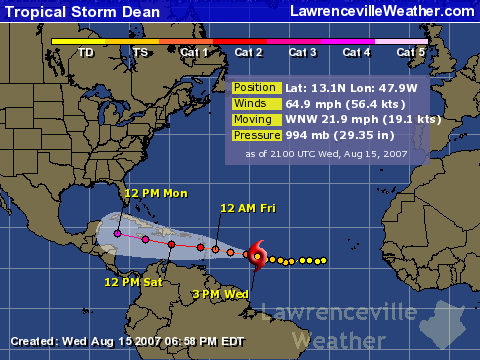Two Storms Threaten to Become Hurricanes
Wednesday, August 15th, 2007After two months of doubting Thomases saying “What hurricane season?”, we not have two tropical storms, at least one threatening to become a hurricane, and both threatening the Gulf of Mexico.
he most immediate threat is Tropical Storm Erin, shown below. Seemingly cropping up out of nowhere last last night, the storm is gaining strength, and before it hits landfall, it should have wind speeds of 63 MPH, about 10 MPH short of hurricane strength. Tropical storm warnings have been posted for South Texas from San Luis Pass southward. While the exact landing point sometime Thursday isn’t certain, storm force winds extend 70 miles out from the center of the storm, and much of the Texas Hill Country could get more than 6 inches of rain — if they haven’t had enough already.

The next actor in this play of tropical weather is Tropical Storm Dean, which will likely become a hurricane by Thursday morning. Dean’s track is shown below:

Dean has been moseying along for a few days now, but is rapidly gaining strength as he approaches the Caribbean. Expected to pass just south of Jamaica on Sunday, the real question is what happens once he reaches the Gulf of Mexico sometime Monday evening. The high pressure system that’s giving Atlanta 100 degree temperatures for the second week in a row is powerful enough at the present time to prevent the storm from recurving to the north.
If the ridge stays strong, the storm will slam into the Yucatan peninsula of Mexico, and some of the models show this to be happening. if it weakens, then the US Gulf is vulnerable to what could be a very powerful hurricane. Since whatever happens is more than five days out, even the best forecasters (and I’m not one of them) aren’t sure what will happen.
Sphere: Related Content

